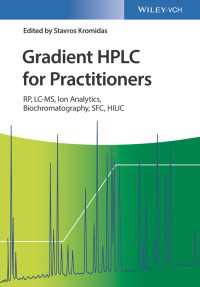グラジエント高速液体クロマトグラフィー実践法Gradient HPLC for Practitioners RP, LC-MS, Ion Analytics, Biochromatography, SFC, HILIC : RP, LC-MS, Ion Analytics, Biochromatography, SFC, HILIC

Full Description
This practical guide for analytical scientists explains the use of gradients in liquid chromatography. The fundamentals of gradient separations, as well as the most common application scenarios are addressed, from LC-MS coupling to biochromatography to the separation of ionic substances. Throughout, this handy volume provides detailed hands-on information for practitioners, enabling them to use gradient separation methods reliably and efficiently.
Table of Contents
Preface ix
The Structure of the Book xi
Notes on Contributors xiii
List of Contributors xvii
Part 1 Principles of Gradient Elution 1
1 Aspects of Gradient Optimization 3 Stavros Kromidas (translated from German by Steve Ross)
1.1 Introduction 3
1.2 Special Features of the Gradient 3
1.3 Some Chromatographic Definitions and Formulas 5
1.4 Detection Limit, Peak Capacity, Resolution – Possibilities for Gradient Optimization 8
1.4.1 Detection Limit 8
1.4.2 Peak Capacity and Resolution 9
1.5 Gradient “Myths” 14
1.6 Examples for the Optimization of Gradient Runs: Sufficient Resolution in an Adequate Time 15
1.7 Gradient Aphorisms 38
2 Instrumental Influences on the Quality and Performance of Gradient Methods and Their Transfer Between Different HPLC Devices 41 Frank Steiner
2.1 Technical Implementation of the Gradient Elution and the Respective Characteristics 41
2.1.1 Low-Pressure and High-Pressure Gradient Proportioning – Two Fundamentally Different Technical Principles 41
2.1.2 The Role of the Mixing Device in HPG and LPG Systems 42
2.1.3 The Operational Principle of Mixing Devices and the Systematic Characterization of Their Effectiveness 47
2.1.4 Effects of Volume Contraction when Mixing Water and Organic Solvents in Gradient Instruments 58
2.1.5 Effects of Minimum Leak Rates of Pump Heads in Sensitive Applications and HPG Synchronization Techniques to Correct Them 63
2.2 The Determination and Significance of the Gradient Delay Volume of the System 65
2.2.1 The Determination of the GDV and its Dependence on the Specific Operation Conditions of the System 66
2.2.2 The Influence of GDV on the Chromatographic Results 76
2.2.3 Possibilities of the User to Influence System GDV and its Impact on Chromatography 77
2.3 The Transfer of Gradient Methods Between Different HPLC Systems 80
2.3.1 Practical Tips for Dealing with Deviating GDVs and Possible Countermeasures 80
2.3.2 The Relevance of the Pressure Dependence of the GDV in Method Transfer 82
2.3.3 Effect of a too High Elution Strength of the Sample Solvent in the Presence of Weakly Eluting Solvent at the Gradient Start 85
2.4 Influence of Fluctuations of the Eluent Composition on the Quality of the Detection 87
2.4.1 Influence of a Reference Channel on the Baseline in Diode Array Detectors 88
2.4.2 The Special Challenge in Methods with UV-Absorbing Retained Additives in the Mobile Phase such as TFA 90
2.5 Other Kinds of Practical Application of Gradient Systems in HPLC 95
2.5.1 Alternative and Combined Gradient Modes in HPLC 96
2.5.2 Advantages in the Implementation of Isocratic Methods with Gradient Instruments 97
2.5.3 Use of Gradient Systems in Method Development and Method Optimization 98
3 Optimization of a Reversed-Phase Gradient Separation Using EXCEL 103 Hans-Joachim Kuss
Part 2 Specifics of the Gradient in Different Elution Modes 111
4 Gradient Elution of Ionic Compounds 113 Joachim Weiss
4.1 Introduction 113
4.2 Theoretical Aspects 114
4.3 Gradient Types in Ion Chromatography 116
4.4 Choice of Eluent 119
4.4.1 Possibilities for Optimizing Concentration Gradients 125
4.5 Gradient Elution of Anions on Anion Exchangers 126
4.6 Gradient Elution of Cations on Cation Exchangers 136
4.6.1 pH Gradients for the Separation of Monoclonal Antibodies 144
4.7 Gradient Elution of Anions and Cations on Mixed-Mode Stationary Phases 148
5 The Gradient in Biochromatography 161 Oliver Genz
5.1 Biomolecules 161
5.2 Biochromatography 161
5.3 The Gradient in Biochromatography 162
5.3.1 A Gradient you Should Definitely Avoid ... 163
5.4 Gradients for Different Biochromatographic Techniques 164
5.4.1 Gel-Filtration, Size-Exclusion Chromatography (SEC) 164
5.4.2 Ion Exchange Chromatography (IEX) 164
5.4.3 Hydrophobic Interaction Chromatography (HIC) 168
5.4.4 Reversed-Phase Chromatography of Biomolecules 170
5.4.5 Affinity Chromatography (AC) 171
5.5 Summary 173
6 Specifications of Gradients in Hydrophilic Interaction Liquid Chromatography (HILIC) 175 Thomas Letzel
7 Specifications of Gradients in Supercritical Fluid Chromatography 183 Stefan Bieber and Thomas Letzel
7.1 Types of Gradients in SFC 183
7.1.1 Mobile Phase Gradients 183
7.1.2 Pressure Gradients 184
7.1.3 Temperature Gradients 185
7.2 Effects of gradients 185
8 Aspects of Gradient Elution in LC-MS Analysis 189 Markus M. Martin
8.1 Role and Importance of Gradient Elution for LC-MS 189
8.2 Technical Aspects of Gradient Elution in LC-MS Analysis 192
8.2.1 Technical Impact of the LC System: System Dispersion, Gradient Proportioning Precision, and How they Affect MS Results 192
8.2.2 Technical Impacts of a Mass Spectrometer: LC Gradients and Signal Generation in the MS 198
8.2.3 Quantitation in Mass Spectrometry Within a Gradient Separation: Matrix Effects and How to Address Them 204
8.2.4 MS Workload Balancing in Gradient Elution – Column Equilibration as a Throughput Bottleneck 206
8.2.5 Gradient Delay, Flow Rate, and Column Dimension – How Far Can we Get With Downsizing of Gradient Separations in LC-MS? 208
8.3 Summary 211
8.4 Abbreviations 211
9 Additional Tools for Method Development: Flow and Temperature Gradients 215 Egidijus Machtejevas
9.1 Introduction 215
9.2 Temperature Gradients 215
9.3 Flow Gradients 216
9.4 Combination of Flow and Temperature Gradients 217
9.5 Case Example 217
9.6 Conclusions 219
Index 223

